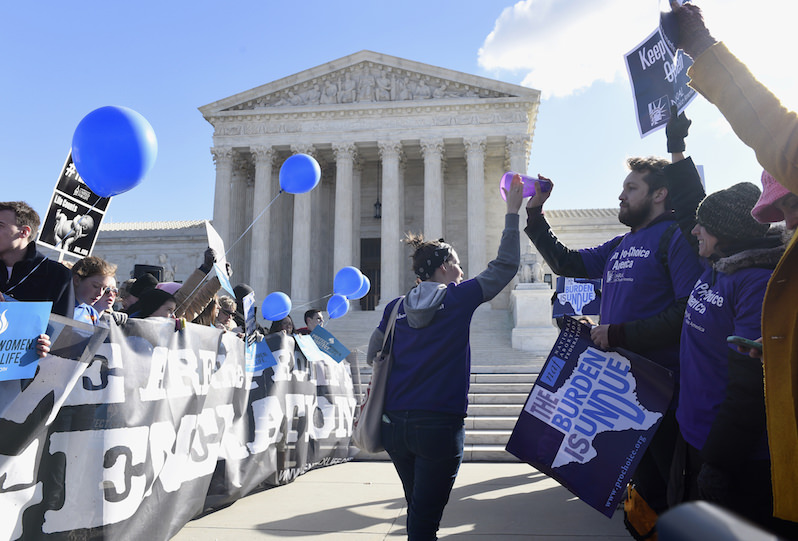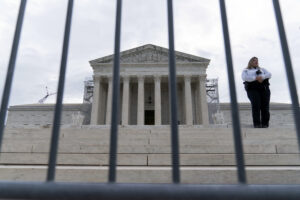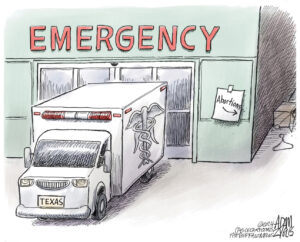Antonin Scalia’s Death Bolsters the Hopes of Abortion-Rights Forces
Before the passing of the hard-right justice created the possibility of a dramatic shift in the Supreme Court, there was fear that Roe v. Wade would be undercut in a pending case. Now beleaguered rights proponents are looking to Justice Anthony Kennedy to swing the ideologically divided bench their way. Protesters on both sides of the abortion issue rally Wednesday outside the Supreme Court. (Susan Walsh / AP)
Protesters on both sides of the abortion issue rally Wednesday outside the Supreme Court. (Susan Walsh / AP)
In November, when the Supreme Court agreed to hear the appeal in Whole Woman’s Health v. Hellerstedt, abortion-rights advocates across the country agonized that the death knell had sounded for Roe v. Wade.
Although the Whole Woman’s Health case technically concerned only two restrictive provisions contained in an omnibus bill, HB2, passed by the Texas Legislature in 2013, pro-abortion-rights groups understandably feared that the Supreme Court would issue an expansive ruling that would weaken the constitutional underpinnings of Roe, if not overturn the landmark 1973 decision outright. With five Republicans on the high tribunal, led by the intemperate Antonin Scalia, the critical question seemed not to be whether the pro-abortion-rights movement would be dealt a setback, but whether the setback would be crippling.
Since Scalia’s death Feb. 13, however, the legal dynamic has shifted dramatically. As Wednesday’s oral arguments in the case illustrated, the anti-abortion forces behind the Texas law at most will come away with a narrow victory. It’s even possible, if Justice Anthony Kennedy, the panel’s most frequent swing voter, opts to join his four Democratic colleagues, they will suffer a once-unthinkable defeat. Rarely has a one-member change in the court’s composition carried such weight.
HB2 is the brainchild of Americans United for Life, a Washington, D.C.-based nonprofit public-interest law and policy organization founded in 1971. AUL helped draft the law and shepherd it to its enactment. As the group’s website informs, its legal team has been involved in every abortion-related case before the Supreme Court since Roe. The model state-level anti-abortion legislation it makes available to interested parties closely resembles the templates put together by the right-wing American Legislative Exchange Council in the fields of economics, immigration and environmental regulation.
AUL also has been at the forefront of a deliberate and steady shift in the anti-abortion movement’s efforts away from an emphasis on fetal personhood to a focus on the alleged harms and risks posed by abortion to the health of pregnant women.
Rather than aiming for an elusive single knockout blow to abortion rights, AUL and other proponents of the new “woman-centered” strategy practice a lethal brand of incrementalism. According to People for the American Way, which has published a comprehensive report on the new strategy—“Chipping Away at Choice” — the AUL’s general counsel reportedly compared his organization’s approach to ending legal abortion to carving a ham, remarking: “Each slice makes it smaller and smaller until it is no more.”
At issue in the Whole Woman’s Health case are two sections of HB2 known as Targeted Regulation of Abortion Providers (TRAP) restrictions. Together, they require that (a) abortion clinics meet all the standards of an ambulatory surgical center (ASC), including those of architectural design such as the width of hallways, and that (b) any physician performing abortions at a clinic have admitting privileges at a hospital within 30 miles of the clinic. Both provisions, the bill’s proponents contend, are intended to protect the well-being of pregnant women.
If permitted to stand, HB2 will effectively close an estimated 34 of the 40 abortion clinics in Texas, leaving abortion facilities operating only in the state’s four largest cities. And the ramifications of the legislation wouldn’t be confined to Texas. According to the Guttmacher Institute, a think tank that has monitored and studied sexual and reproductive health issues for five decades, 24 states to date have enacted some form of TRAP regulation. All would be fortified if the Supreme Court approved HB2.
Judging from Wednesday’s oral arguments, however, without Scalia the court might split evenly on whether HB2 indeed passes constitutional muster. Although Kennedy joined with the court’s Democrats last summer to stay the decision of the 5th Circuit Court of Appeals that had upheld HB2, he is no supporter of abortion rights. Since his confirmation in 1988, Kennedy has deliberated in 12 abortion cases involving some 21 laws restricting the procedure. He has voted 20 times to uphold the restrictions.
During the Whole Woman’s Health arguments, however, Kennedy was especially hard to read. Instead of offering a substantive position on HB2, he asked whether the case ought to be remanded to the 5th Circuit for additional fact-finding about the law’s impact on women seeking abortions.
Chief Justice John Roberts, along with Justice Samuel Alito, seemed clearly to align with Texas Solicitor General Scott Keller in support of the law. Alito was particularly aggressive, insinuating that there was in fact no proof that HB2 actually had led to the closure of any abortion clinics in the state. Justice Clarence Thomas, as is his wont, remained silent.
Taking the opposite tack, the court’s four liberals—Justices Ruth Bader Ginsburg, Stephen Breyer, Sonia Sotomayor and Elena Kagan—peppered Keller with pointed questions suggesting that the law would have a harsh impact, especially on poor women, and emphasizing the medical safety of abortion generally.
Should Kennedy decide to remain true to his anti-abortion record, he’ll have ample legal wiggle room to do so. From a constitutional perspective, abortion restrictions are no longer evaluated by the analytical standards set forth in Roe v. Wade but by a more relaxed test adopted in the court’s 1992 decision in Planned Parenthood v. Casey.
Roe recognized that a woman’s prerogative to terminate pregnancy before fetal viability is a fundamental privacy right founded in the 14th Amendment’s concept of personal liberty. State laws limiting that right had to satisfy what constitutional lawyers and judges call “strict scrutiny,” meaning that they had to be narrowly tailored to further and actually accomplish a “compelling state interest.” In the Planned Parenthood case, the court upheld the constitutional right to an abortion. However, in place of Roe’s strict scrutiny, the court adopted an “undue burden” standard of review, holding in a highly fractured set of individual opinions that abortion restrictions should be invalidated if their purpose or effect was “to place a substantial obstacle in the path of a woman seeking an abortion before the fetus attains viability.”
Since the Planned Parenthood decision, abortion restrictions have mushroomed across the country, ranging from laws tying abortions to specified stages of fetal gestation to prohibitions on public-funding and parental-involvement mandates. The Guttmacher Institute has reported that 51 new abortion restrictions were enacted nationwide just in the first half of 2015.
From a strictly legal standpoint, the undue burden test presents a panoply of problems. Foremost are the test’s vagueness and its malleability in the hands of judicial ideologues.
The three-judge panel of the 5th Circuit that endorsed the constitutionality of HB2 last year consisted of two appointees of George W. Bush and one nominee of Ronald Reagan. In a unanimous, unsigned per curiam ruling, they held that the undue burden test required them to approve HB2 as long as there was “any conceivable rationale … for its enactment” and regardless of whether the law in fact advanced the rationale of promoting women’s health.
In truth, of course, HB2 and similar laws around the country are little more than cynical smokescreens masquerading as concern for pregnant women. The American Medical Association, the American College of Obstetricians and Gynecologists, the American Academy of Family Physicians and other leading medical organizations are united in their opposition to HB2.
In an amicus curiae brief submitted in the Whole Woman’s Health case, these associations assert what hundreds of thousands of American women experience firsthand each year: that abortion is an extremely safe medical procedure. Nationally, as the brief notes, the risk of death resulting from an abortion is a mere 0.6 per 100,000 (or 0.0006 percent). In Texas, the risk is lower still. From 2009 through 2013, there were zero reported deaths in the more than 360,000 abortions performed. No competent medical evidence suggests that the procedure would be safer if performed in more expensive ambulatory surgical centers.
Similarly, there is no valid medical reason to require that all abortion physicians have hospital admitting privileges, especially in a vast and largely rural state like Texas. To draw again on the AMA’s brief, doctors are often denied admitting privileges for reasons entirely unrelated to their competency or quality of care. And in those rare instances when a woman experiences serious complications during or immediately after an abortion, hospitals are obligated to admit and treat them.
Writing in a post Monday for The Atlantic magazine’s online edition, University of Baltimore law school professor Garrett Epps observed that if HB2 is permitted to take full effect, “nearly 1 million women of reproductive age [in Texas] would find themselves more than 150 miles from a facility that could perform an abortion, and would need to wait more than three weeks for an appointment to receive one.”
Whether Justice Kennedy concludes that such roadblocks represent undue burdens won’t be known until the court’s current term concludes in June. What is all but assured, however, is that the anti-abortion movement will fall far short of its anticipated goals in the case.
If Kennedy doesn’t vote to overturn HB2 and the court splits 4-4 along party lines, it will have three basic options: First, it could, as Kennedy has already hinted, remand the case to the 5th Circuit for additional development of the record, essentially punting on the entire matter.
Second, it could issue an evenly divided decision that would have no precedential value. In such event, the court’s action would defer to the 5th Circuit’s ruling, effectively affirming it by default. But the circuit court’s opinion would apply only to Texas and the two other states within its jurisdiction, Louisiana and Mississippi. Other federal circuits would be free to adopt different interpretations of the undue burden test, as the 7th Circuit already has.
In the alternative, the court could order the case to be reheard next year, after the presidential election, hoping that the vacancy left by Scalia’s death might be filled by then. Given the nation’s profound political dysfunction, however, there’s no telling how long it will take for Scalia’s successor to be confirmed, and there is no guarantee that he or she would bring a similar anti-abortion zeal to the bench. The new justice might even be — heaven forfend — open-minded on the issue, leaving the ultimate resolution of the case pending until at least June 2017.
In any event, the most important justice in Wednesday’s hearing was the one who wasn’t there: Antonin Scalia. Although his untimely demise is regrettable in strictly human terms, his death nonetheless has injected new life into the pro-abortion-rights ranks.
Your support matters…Independent journalism is under threat and overshadowed by heavily funded mainstream media.
You can help level the playing field. Become a member.
Your tax-deductible contribution keeps us digging beneath the headlines to give you thought-provoking, investigative reporting and analysis that unearths what's really happening- without compromise.
Give today to support our courageous, independent journalists.






You need to be a supporter to comment.
There are currently no responses to this article.
Be the first to respond.